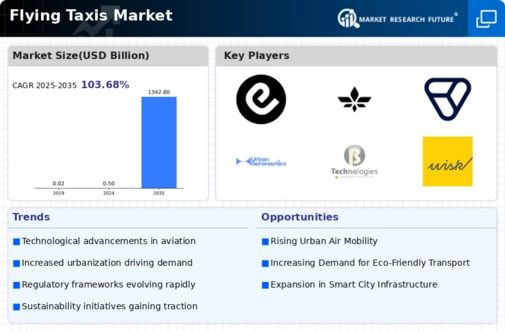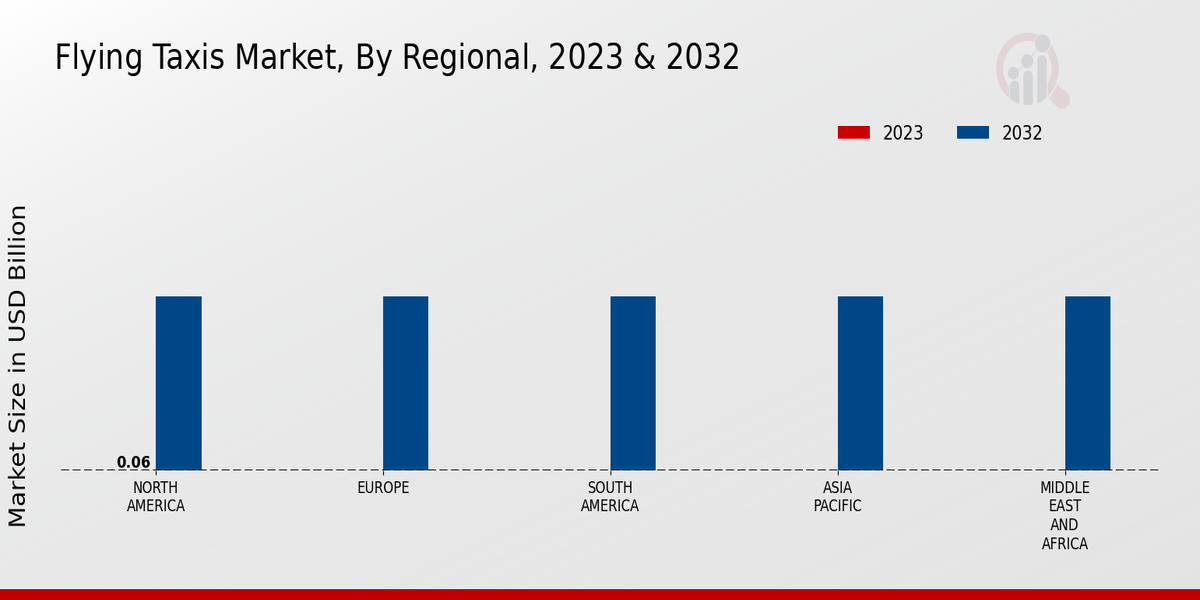Urbanization Trends
The Global Flying Taxis Market Industry is significantly influenced by ongoing urbanization trends. As cities expand and populations increase, traditional ground transportation systems face congestion challenges. Flying taxis offer a viable solution to alleviate traffic woes, providing rapid transit options in densely populated areas. For example, urban centers like Los Angeles and Singapore are exploring flying taxi services to enhance mobility. This shift towards aerial transportation is expected to drive market growth, with a projected compound annual growth rate (CAGR) of 104.99% from 2025 to 2035, indicating a robust demand for innovative transport solutions.
Market Growth Projections
The Global Flying Taxis Market Industry is characterized by remarkable growth projections. With an expected market value of 0.5 USD Billion in 2024, the industry is poised for exponential expansion, potentially reaching 1342.8 USD Billion by 2035. This trajectory suggests a compound annual growth rate (CAGR) of 104.99% from 2025 to 2035, reflecting the increasing demand for aerial mobility solutions. Such growth may be driven by advancements in technology, urbanization, and supportive regulatory frameworks. The market's evolution could redefine urban transportation, making flying taxis a viable alternative to traditional ground-based systems.
Technological Advancements
The Global Flying Taxis Market Industry is propelled by rapid technological advancements in electric vertical takeoff and landing (eVTOL) aircraft. Innovations in battery technology, such as increased energy density and reduced charging times, enhance the feasibility of flying taxis. For instance, companies are developing hybrid-electric systems that could extend flight range and efficiency. As these technologies mature, they are expected to lower operational costs, making flying taxis more accessible. The anticipated growth in this sector is evident, with projections indicating a market value of 0.5 USD Billion in 2024, potentially skyrocketing to 1342.8 USD Billion by 2035.
Environmental Sustainability
The Global Flying Taxis Market Industry is also driven by the growing emphasis on environmental sustainability. As concerns about climate change intensify, there is a shift towards greener transportation solutions. Flying taxis, particularly those powered by electric or hybrid systems, present an opportunity to reduce carbon emissions associated with urban travel. Governments and consumers alike are increasingly prioritizing eco-friendly options, which could lead to a surge in demand for flying taxis. This trend aligns with global sustainability goals, further solidifying the market's potential for growth in the coming years.
Investment and Funding Opportunities
Investment and funding opportunities are pivotal in the evolution of the Global Flying Taxis Market Industry. Venture capitalists and private equity firms are increasingly channeling funds into flying taxi startups, recognizing the market's potential for substantial returns. This influx of capital supports research, development, and the commercialization of flying taxi technologies. Notably, the market's projected growth from 0.5 USD Billion in 2024 to 1342.8 USD Billion by 2035 underscores the lucrative prospects that attract investors. As financial backing strengthens, it is likely to accelerate the pace of innovation and deployment in the sector.
Government Initiatives and Regulations
Government initiatives play a crucial role in shaping the Global Flying Taxis Market Industry. Regulatory bodies are increasingly recognizing the potential of flying taxis and are establishing frameworks to facilitate their integration into existing air traffic systems. Countries like the United States and the United Kingdom are investing in research and development, as well as creating policies that support the safe operation of eVTOL aircraft. These initiatives not only enhance public safety but also encourage private investment in the sector. As regulations evolve, they are likely to foster a conducive environment for market expansion.























